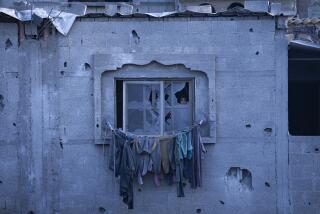‘Last Days’: Powerful Holocaust Stories From Hungarians
At the beginning of the eloquent Holocaust documentary “The Last Days,” a vigorous retired businessman named Bill Basch tells us how the Nazis might have managed to draw out World War II by as much as six months had they not been so intent on carrying out the Final Solution.
Basch knows of where he speaks; he is one of five Hungarian Holocaust survivors who for this film agreed to return to the concentration camps and hometowns they had not seen for more than half a century in order to give us a sense of the full impact of the horrors that must never be forgotten.
For the record:
12:00 a.m. Feb. 6, 1999 For the Record
Los Angeles Times Saturday February 6, 1999 Home Edition Calendar Part F Page 14 Entertainment Desk 1 inches; 36 words Type of Material: Correction
Wrong identification--In Friday’s review of the film “The Last Days,” the woman who confronted former Nazi concentration camp doctor Hans Munch about medical experiments on her sister was misidentified. It was Renee Firestone who had that encounter.
Indeed, the familiar atrocity images here are, in fact, stronger and more substantial than in most other, if not all other, Holocaust documentaries. But they are sustained by the humanity, intelligence and dignity of these five people who witnessed and survived the atrocities firsthand. All of them are longtime American citizens, and all are either in their late 60s or early- to mid-70s. They are all well-dressed people who live in nicely furnished homes. They do not look like victims, and, in fact, they are not. They are survivors who endured the unspeakable, who lost everything but who had the courage and determination to build new, rewarding lives in a new country.
Both Renee Firestone and Irene Zisblatt were born in storybook Czech towns that were annexed to Hungary. They speak of their idyllic childhoods shattered by the German invasion of Hungary on March 19, 1944. For two years, Prime Minister Miklos Kallay’s government had resisted implementing the Final Solution, but after the Germans’ arrival, Hungary’s Jewish community was systematically eradicated with desperate, unprecedented brutality. In 1941 Hungary had a Jewish population of 825,000, but by the time the war was over, 620,000 of them were dead.
Having grown up integrated within the Gentile community, Zisblatt recounts her shock at the anti-Semitism that erupted once her town, a mineral springs resort, had been annexed to Hungary. Congressman Tom Lantos, who tells us how he owes his life to the efforts of Swedish diplomat Raoul Wallenberg, speaks of the naive patriotism of the Hungarian Jews. Lantos survived in his native Budapest in a Wallenberg safe house, but artist Alice Lok Cahana, another Budapest native, ended up in Bergen-Belsen. Firestone and Zisblatt were sent to Auschwitz, where Zisblatt was selected for medical experimentation, and Basch was sent to Buchenwald. All of them would lose their immediate relatives in the camps.
What these five and others have to say may be familiar to many by now, but the experiences they lived through are so terrible and told in such riveting detail it’s as if you’re hearing about the Holocaust for the first time.
And there are those personal touches that make their stories unforgettable. Firestone tells us of trying to save a bathing suit as a memento of far happier times, and Zisblatt talks of her determination to preserve the diamonds sewn into her clothes by the mother she would never see again. Cahana, intent upon learning of the fate of her beloved sister, has an astounding, chilling interview with the very doctor who apparently performed experiments upon her sibling. Dr. Hans Munch was acquitted at Nuremberg because he seemingly was able to prove that he performed harmless experiments on prisoners as a way of helping to extend and thereby save lives. Yet with Cahana he proves evasive, stating that it was “only normal” that after six months in captivity her sister should die.
“The Last Days” is the first theatrical feature produced by the Survivors of the Shoah Visual History Foundation, founded by Steven Spielberg in 1994, who served as the documentary’s executive producer. It was directed with the utmost sensitivity by James Moll, and has a score by Hans Zimmer that is at once understated and elegiac. The words of the survivors are augmented by a trove of deftly interwoven archival material, much of it unfamiliar and all of it overwhelmingly powerful. What “The Last Days” ultimately evokes, beyond celebrating these five remarkable people, is the sense that evil is eternal within human nature. “Evil is always with us,” Lantos says. “We must fight it every moment of our lives.”
* MPAA rating: PG-13, for graphic images and descriptions of Holocaust atrocities. Times guidelines: The film is too intense for children.
‘The Last Days’
An October Films release of a Survivors of the Shoah Visual History Foundation production. Director-editor James Moll. Producers June Beallor, Ken Lipper. Executive producer Steven Spielberg. Cinematographer Harris Done. Music Hans Zimmer. Running time: 1 hour, 27 minutes.
Exclusively at the Music Hall, 9036 Wilshire Blvd., Beverly Hills, (310) 274-6869.
More to Read
Only good movies
Get the Indie Focus newsletter, Mark Olsen's weekly guide to the world of cinema.
You may occasionally receive promotional content from the Los Angeles Times.










